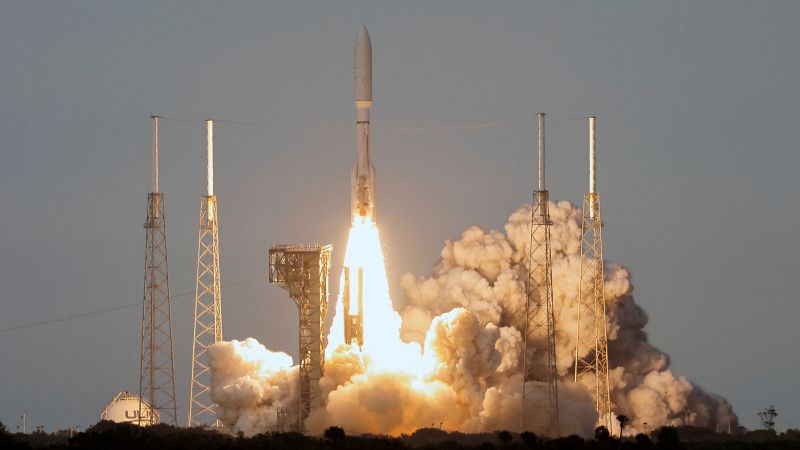Amazon Launches into Orbit: A New Challenger for Space Internet
The cosmos is getting crowded! Amazon has officially joined the race to provide global internet access from space. On Monday, an Atlas V rocket carrying 27 satellites for Amazon’s Project Kuiper soared into low-Earth orbit from Cape Canaveral, Florida. This launch signifies a major step in the tech giant’s ambitious plan to blanket the planet with internet connectivity. This move pits Amazon directly against Elon Musk’s SpaceX, whose Starlink network has already gained a significant foothold in the market with millions of subscribers worldwide. The competition promises to reshape how we access the internet, particularly in remote areas where traditional broadband is lacking. The success of Project Kuiper, however, is far from guaranteed.
The endeavor is exceptionally complex, with thousands of satellites needed, all orbiting closely to Earth and traveling at speeds exceeding 17,000 miles per hour. These satellites must work in perfect harmony to ensure seamless connections with user dishes and ground infrastructure. While SpaceX has established a commanding lead, Amazon hopes to catch up with a constellation of roughly 3,200 satellites in the first phase. These satellites will operate at a slightly lower altitude than Starlink’s, providing an advantage in speed. The question remains whether Amazon can compete with SpaceX’s established dominance and pricing strategy. Amazon’s entrance into this market is being met with a healthy dose of skepticism from analysts, who question whether it’s too late for the company to make a significant impact. The financial stakes are high, and the race to provide global internet access is just beginning.
The Kuiper Constellation: How It Works
Project Kuiper, like Starlink, aims to deliver high-speed, low-latency internet access by leveraging a network of satellites orbiting close to Earth. Unlike traditional communication satellites in geostationary orbit, which are positioned much further away, Kuiper’s satellites will operate in low-Earth orbit (LEO). This proximity significantly reduces the time it takes for data to travel, resulting in faster internet speeds and improved responsiveness for users. Each satellite in the Kuiper constellation will orbit approximately 280 miles above the Earth’s surface. This will enable the provision of internet services to individuals and businesses in remote regions. The speed of light means that signals travel faster in LEO compared to geosynchronous orbit. The design of the satellites, ground stations, and user terminals are critical for Kuiper’s success. The goal is to provide a seamless, reliable internet experience, regardless of the user’s location.
The first generation of Kuiper satellites will form the backbone of Amazon’s initial internet service, and will be followed by subsequent generations that can incorporate performance improvements and new features. The strategic location of the satellites within the constellation is vital, ensuring that there is coverage across the targeted geographic areas. The technological prowess required for this project is extraordinary. The satellites need to maintain their position in orbit and communicate with each other. Amazon also needs to integrate advanced technologies, such as sophisticated beam-forming antennas, to direct the internet signals to the appropriate locations on Earth. Amazon’s plan is to provide a global internet service which requires meticulous engineering and operation across many different areas of expertise.
The Hurdles Facing Amazon in the Space Race
While the launch of the first Kuiper satellites is a momentous occasion, Amazon faces numerous challenges in its quest to compete with SpaceX. One of the primary obstacles is the sheer cost of building and deploying a massive satellite constellation. Estimates suggest that establishing the initial Kuiper system could cost as much as $17 billion upfront. The financial burden doesn’t end there. Ongoing operational costs, including satellite maintenance, ground station operations, and software updates, could amount to an additional $1 billion to $2 billion annually. The ability to match SpaceX’s pricing strategy is another key consideration. While the price of Starlink has fluctuated, Amazon will need to offer competitive rates to attract customers and gain market share. SpaceX has a significant head start, and Amazon will need to quickly ramp up production and deployment of its satellites to catch up. The challenge is even greater when considering the regulatory hurdles involved in obtaining the necessary licenses and approvals to operate a global internet service. This includes navigating international agreements and complying with various space regulations.
Amazon also needs to demonstrate that its technology can meet the performance expectations of users. This includes providing reliable internet speeds, low latency, and consistent service availability. The company’s past endeavors in the internet service space demonstrate its ambition to deliver a top-notch customer experience. The success of Project Kuiper relies on Amazon’s ability to overcome these formidable obstacles. Success will require not only financial resources, and technological expertise, but also a well-executed strategy. The pressure is high as the company strives to make its mark in the highly competitive world of satellite internet.
The Broader Implications of the Space Internet
The rise of satellite internet has far-reaching implications, potentially transforming how we connect and communicate. For consumers, satellite internet offers the promise of high-speed internet access in areas where traditional broadband is unavailable or unreliable. For businesses, it provides the connectivity needed to operate in remote locations, enabling new opportunities for growth and expansion. It promises to bridge the digital divide by bringing the benefits of the internet to underserved communities and expanding access to education, healthcare, and economic opportunities. Satellite internet can also provide connectivity for critical infrastructure, such as emergency services, and enable the delivery of crucial services in times of crisis. Satellite internet will create new possibilities in areas like in-flight Wi-Fi and maritime connectivity, enhancing travel experiences and enabling seamless communication at sea. The impact extends beyond simply providing access to the internet.
The shift in power dynamics within the telecommunications industry will impact traditional telecom providers. The launch of satellite internet services will force these providers to adapt and innovate. The convergence of the space and internet industries is creating new business models and investment opportunities. Satellite internet will be a significant driver of innovation, accelerating advancements in satellite technology, antenna design, and network management. The long-term implications of satellite internet will affect national security, with satellite constellations playing a critical role in providing secure and reliable communications. As the space internet becomes a reality, the world will see changes in how we live, work, and interact. These changes are being driven by a combination of technological advancements and the evolving needs of a globalized world. The future of the internet will be shaped by the companies and governments that embrace the potential of space-based connectivity.
Can Amazon Succeed in the Space Race?
The launch of Project Kuiper satellites marks a significant step in Amazon’s ambition to become a major player in the space internet industry. The path to success will be challenging. Amazon faces tough competition from SpaceX, as well as other emerging players in the satellite internet market. Amazon has to demonstrate its technological capabilities, deploy its satellites rapidly, and offer competitive pricing. Amazon will need to convince both consumers and investors that it can compete with an established market leader. The long-term success of Project Kuiper could have a lasting impact on the company and the world. The stakes are high, and the space internet race is far from over.




